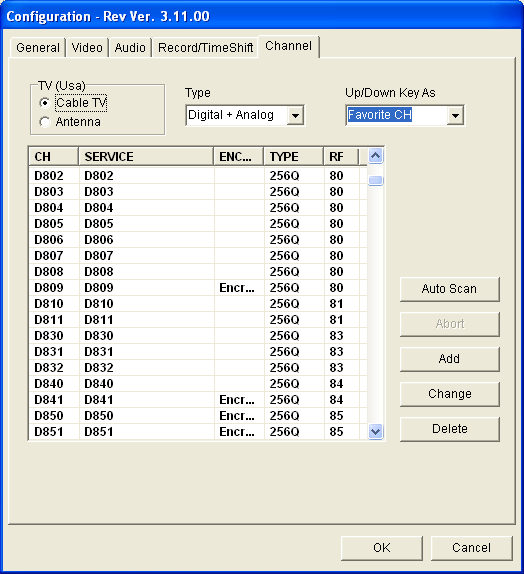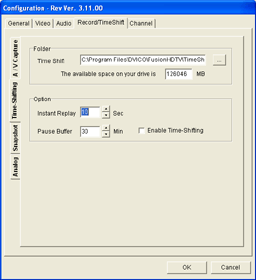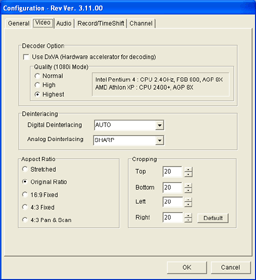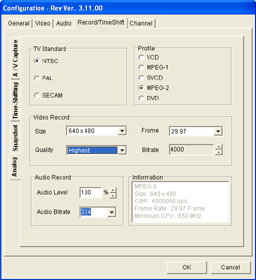HTPC - TV Tuner Reviews
by Jarred Walton on December 7, 2005 12:05 AM EST- Posted in
- Smartphones
- Mobile
DVICO Fusion5 Gold (cont'd)
The Fusion5 card can function in multiple ways, and how you plan to use the card will affect the configuration process. FusionHDTV supports standard analog TV reception, OTA DTV reception, and the ability to decode digital cable content (provided that it isn't encrypted). These last two features are also referred to as the ability to decode 64/256 bit QAM content (for digital cable) and 8VSB content (for OTA DTV).
When you first launch FusionHDTV, it will ask if you want to scan for channels. Say "no" and then specify the type of connection that you're using first: cable or antenna, and then select analog, digital or both for the channel type. At this point, you can click the "Start Scan" button and wait a few minutes. (It took about 4.5 minutes to scan through the digital channels and another 1.5 minutes for the analog channels.)
Most of the configuration options are pretty much self-explanatory. You can see several of the screens above. Timeshifting is grayed out on analog channels but is available for digital channels. Depending on which station you're currently tuned in to, you may or may not be able to check the timeshifting box.
The video options allow you to specify how the content should be shown. "Original Ratio" is our preferred choice, as any form of stretching tends to look bad. Some people don't like having black areas on widescreen displays, though, so the ability to switch to a stretch or zoom mode will keep them happy. The remote actually has a button that toggles between these three modes, which can come in handy.
Digital and analog recording have separate options, although the computer speed may play a role in what you select. You can capture digital streams as either the raw transport stream (with a .TP extension) or as a "Native MPEG" stream. "Native MPEG" mode converts the transport stream to a program stream (.MPEG extension), which usually has very little impact on performance or file size (and no impact on quality). However, it can save a lot of space if you're capturing an SDTV show where there are lots of extra bytes for other subchannels or null packets in the TS that are stripped from the PS. Given this information, Native MPEG seems to be the better choice, though in our sample videos (which were of HDTV), we chose to capture the raw TS.
Analog capture only allows MPEG2 encoding, but with several quality presets available. Choosing 640x480 and Highest Quality result in a data rate of 4000 Kbits/s and little to no loss in quality, so that's what we chose. That will use around 30 MB per minute of video - that's one-fourth to one-fifth the amount of disk space as a typical 720p/1080i HD transport stream, in case you were wondering. With hard drives costing around 40 cents per GB for the best deals, we recommend grabbing a 250GB drive (or several) and using higher quality capture options rather than worrying about disk space.
The Fusion5 card can function in multiple ways, and how you plan to use the card will affect the configuration process. FusionHDTV supports standard analog TV reception, OTA DTV reception, and the ability to decode digital cable content (provided that it isn't encrypted). These last two features are also referred to as the ability to decode 64/256 bit QAM content (for digital cable) and 8VSB content (for OTA DTV).

When you first launch FusionHDTV, it will ask if you want to scan for channels. Say "no" and then specify the type of connection that you're using first: cable or antenna, and then select analog, digital or both for the channel type. At this point, you can click the "Start Scan" button and wait a few minutes. (It took about 4.5 minutes to scan through the digital channels and another 1.5 minutes for the analog channels.)
 |
 |
| Click to enlarge. | |
Most of the configuration options are pretty much self-explanatory. You can see several of the screens above. Timeshifting is grayed out on analog channels but is available for digital channels. Depending on which station you're currently tuned in to, you may or may not be able to check the timeshifting box.
The video options allow you to specify how the content should be shown. "Original Ratio" is our preferred choice, as any form of stretching tends to look bad. Some people don't like having black areas on widescreen displays, though, so the ability to switch to a stretch or zoom mode will keep them happy. The remote actually has a button that toggles between these three modes, which can come in handy.
 |
 |
| Click to enlarge. | |
Digital and analog recording have separate options, although the computer speed may play a role in what you select. You can capture digital streams as either the raw transport stream (with a .TP extension) or as a "Native MPEG" stream. "Native MPEG" mode converts the transport stream to a program stream (.MPEG extension), which usually has very little impact on performance or file size (and no impact on quality). However, it can save a lot of space if you're capturing an SDTV show where there are lots of extra bytes for other subchannels or null packets in the TS that are stripped from the PS. Given this information, Native MPEG seems to be the better choice, though in our sample videos (which were of HDTV), we chose to capture the raw TS.
Analog capture only allows MPEG2 encoding, but with several quality presets available. Choosing 640x480 and Highest Quality result in a data rate of 4000 Kbits/s and little to no loss in quality, so that's what we chose. That will use around 30 MB per minute of video - that's one-fourth to one-fifth the amount of disk space as a typical 720p/1080i HD transport stream, in case you were wondering. With hard drives costing around 40 cents per GB for the best deals, we recommend grabbing a 250GB drive (or several) and using higher quality capture options rather than worrying about disk space.










77 Comments
View All Comments
JarredWalton - Thursday, December 8, 2005 - link
The only system it impacted was the MyHD for analog. I did perform most of the tests at stock clock speeds. But yeah, I should probably make that note. (The X2 was overclocked to 2.6 GHz as well, if you didn't notice, but I only tested the MyHD card in that system.)The Boston Dangler - Wednesday, December 7, 2005 - link
"While the Toshiba 46H84 is in fact a 1080i display - or really a 1920x540p display, if I understand it correctly"The display has 1080 horizontal lines of resolution, scanned alternately. 1080i format signals carry data roughly equivalent of 540p.
My opinion: Having owned both 1080i and 720p sets, and watching programs in their native formats, the difference in pic quality is entirely upon the display. There are both formats present in OTA/Cable, something always gets converted. Either format can provide great pics, even after conversion. It's all about the display.
"The onscreen Guide also doesn't work for me - it shows up blank - but this appears to be at least partly Comcast's fault. The FusionHDTV software is supposed to read the EPG information from the channel stream, but Comcast isn't including that in my area, as far as I can tell. (This was a problem on the MyHD as well, so that lends credence to the assumption that the local Comcast provider is to blame.)"
EPG is usually considered an extra service by content providers, thus a cable box and subscription are required. There are online alternatives, sometimes with handy plugins.
slashdotcomma - Wednesday, December 7, 2005 - link
What's the lag between signal and display? Would I be able to use any of these tuner cards and play on a gamecube,xbox(360),ps2/3, etc?JarredWalton - Wednesday, December 7, 2005 - link
I'm not quite sure what you mean. Are you trying to capture videos of your gameplay? Or just get the game console input onto your computer screen? Tuning to digital channels introduces about a two second lag, and on analog channels it's more like a .5 second to one second lag. Obviously, neither of those would be acceptable for gaming. It sounds like what you really want would be some form of transcoder?Note: it never even occurred to me to test this aspect of the cards, and I don't have a game console with which to test it. Sorry -- I'm a PC gamer. :-)
slashdotcomma - Wednesday, December 7, 2005 - link
Yes, I'm trying to get the game console input onto my computer screen. Lag for changing channels and lag between signal and screen is slightly different. For example, I played around with an AIW-9800 pro and changing channels would introduce a slight lag, but playing game consoles on it was beautiful. No lag, and everything was smooth as silk (p42.8c, 1gb ram, don't remember which MMC v9 it was). Actually it doesn't even have to be a video console, try plugging in a dvd player or vcr and try moving around in the menu. I wish more reviewers would add this to part of their reviews. I plan on playing around with Dscaler if I get the chance. There are ways to hook up game consoles to computer screen but you lose the recording ability and in some cases DVI support. Do you have a chance to play around with the older tv tuners as well?JarredWalton - Wednesday, December 7, 2005 - link
I don't have any older TV Tuners, though Anand might still have some of them. I'll have to see if I can get a game console over to try out in this fashion. I might actually have an N64 boxed up somewhere. I use PCs for DVD watching, and I don't have a VCR either, so it's going to take a bit of work. I do know that if I tune in the Comcast box to an analog channel and at least one or two of the tuners (I don't recall which), they were not in sync with each other; the Comcast was slightly ahead all the time, so it seems like lag is present.sprockkets - Wednesday, December 7, 2005 - link
I record for example LOST from the s-video out on my HDTV receiver, and it goes to a Lite On recorder on highest quality, and if you see it you would be hard pressed to tell the difference. Or, you can simply record 720x480 at a high quality via s-video in and get the same results on these cards. Of course that means setting up two devices.Does HDTV recording from these cards preserve the Dolby Digital 5.1 signal as well?
segagenesis - Wednesday, December 7, 2005 - link
Yes, they should. If you have ever checked out any of the Lost tv torrents you would be familiar that this is possible also ;)vailr - Wednesday, December 7, 2005 - link
ATI's MMC v. 9.10 may work with 550 tuner cards, according to this thread:http://www.rage3d.com/board/showthread.php?t=33835...">ATI words on MMC 9.10: Dual-tuner MulTView + 550 support!
Combined with their Gemstar GuidePlus software, would enable an electronic program guide.
Note: MMC 9.10 is not currently available on ATI's web site; only on the software CD provided with their latest XT180AIW card.
vailr - Wednesday, December 7, 2005 - link
The link is for the older PCI version, not the currently reviewed PCIe version.